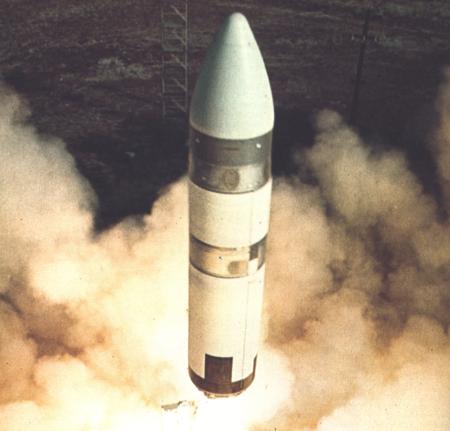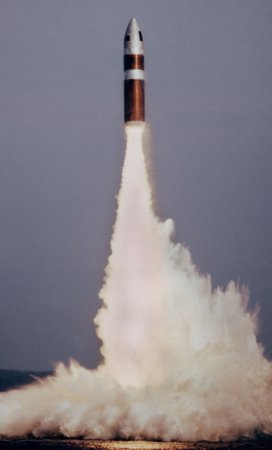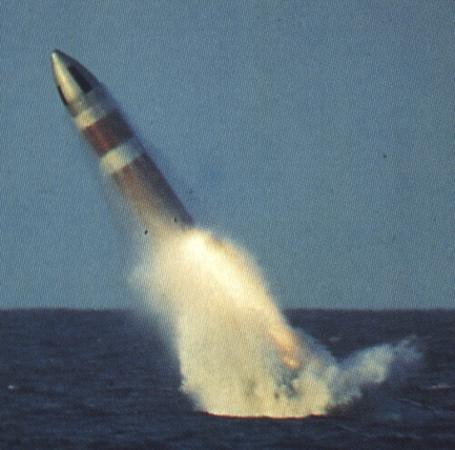Lockheed UGM-73 Poseidon
The Poseidon was a direct develepment of the UGM-27 Polaris SLBM (Submarine-Launched Ballistic Missile), and succeeded the latter in U.S. Navy service.
In 1963, the Navy studied the development of a Polaris derivative enlarged to the maximum dimensions allowed by the existing Polaris launch tubes. In November 1963, this project became known as Polaris B-3, and at that time, one of the major goals was to increase range to 5600 km (3500 miles). During 1964, a MIRV (Multiple Independent Reentry Vehicle) warhead was introduced in the design, while the requirement for increased range was shelved. In early 1965, the missile was renamed as Poseidon C-3 (at least partly politically motivated, to stress that the new missile was more than a simple upgrade of Polaris), and later that year, the projected missile was allocated the formal designation of ZUGM-73A. The first launch of an UGM-73A missile occurred in August 1968, and the first submerged launch from USS James Madison (SSBN-627) succeeded in August 1970. In March 1971, the Poseidon was declared operational on SSBN-627. Other Lafayette (SSBN-616) class Polaris-equipped submarines were subsequently converted to Poseidon during regular reactor refits.
 |
| Photo: U.S. Navy |
| UGM-73A |
Like the UGM-27 Polaris, the UGM-73A was a two-stage solid-fueled missile, each stage having a single nozzle with thrust-vectoring control. It used essentially the same inertial navigation system as the UGM-27 with an accuracy of about 550 m (0.3 nm) CEP. While the Poseidon was only marginally longer than the UGM-27C Polaris A-3, the diameter was noticably larger. The was made possible by a redesign of the shock-attenuation systems in the launch tubes, allowing the removal of the liner in the tube. Range of the UGM-73A was only slightly higher than that of Polaris because of the bigger warhead section. The latter normally carried ten MK 3 independent reentry vehicles with a W-68 thermonuclear (50 kT) warhead. A load of up to 14 RVs could be fitted, reducing missile range from 5280 km (2850 nm) to about 4000 km (2200 nm). The low-yield warheads were deliberately chosen so that Poseidon was not suitable as a first-strike weapon against Soviet hardened strategic targets, but very effective as a retaliation weapon against "soft" targets (like cities). Because it was feared at the time, that an effectively invulnerable high-precision high-power SLBM would destablize the nuclear balance of deterrance, the development of a new stellar-inertial guidance system and high-yield warhead was not approved by the Department of Defense.
 |
 | |
| Photo: Lockheed Martin Missiles & Space | Photo: U.S. Navy | |
| UGM-73A | ||
The first production Poseidon missiles suffered from severe reliability problems. These affected many components, including the nuclear warheads, some of which were defective to the point which would have prevented detonation. The problems were not solved until 1974. Beginning in October 1979, the Poseidon was gradually replaced by its successor, the UGM-96 Trident I C-4, and the last Poseidon submarine was decommissioned in September 1992. Between 1970 and 1978, Lockheed built about 620 UGM-73A missiles.
 |
| Image: Lockheed Martin Missiles & Space |
| SLBM family: UGM-27A, UGM-27B, UGM-27C, UGM-73A, UGM-96A, UGM-133A |
Specifications
Note: Data given by several sources show slight variations. Figures given below may therefore be inaccurate!
Data for UGM-73A:
| Length | 10.39 m (34 ft 1.2 in) |
| Diameter | 1.88 m (6 ft 2 in) |
| Weight | 29200 kg (64400 lb) |
| Speed | > 12900 km/h (8000 mph) |
| Ceiling | > 800 km (500 miles) |
| Range | 5280 km (2850 nm) |
| Propulsion | 1st stage: Hercules/Thiokol solid-fueled rocket 2nd stage: Hercules solid-fueled rocket |
| Warhead | 10x W-68 thermonuclear (50 kT) in 10x MK 3 RV |
Main Sources
[1] James N. Gibson: "Nuclear Weapons of the United States", Schiffer Publishing Ltd, 1996
[2] Norman Friedman: "US Naval Weapons", Conway Maritime Press, 1983
[3] Bill Gunston: "The Illustrated Encyclopedia of Rockets and Missiles", Salamander Books Ltd, 1979
[4] René J. Francillon: "Lockheed Aircraft since 1913", Putnam, 1987
Back to Current Designations Of U.S. Unmanned Military Aerospace Vehicles
Back to Directory of U.S. Military Rockets and Missiles
Last Updated: 12 February 2002